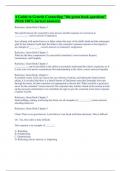Samenvatting
Summary Glossary of all the concepts in the course "The Psychology of Economic Behavior".
- Instelling
- Universiteit Leiden (UL)
This is a really convenient glossary of all the concepts that are described in the lectures of the Psychology of Economic Behavior. It helped me a lot while studying and made the course a lot more clear to me.
[Meer zien]













